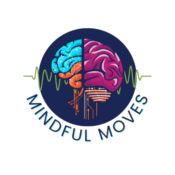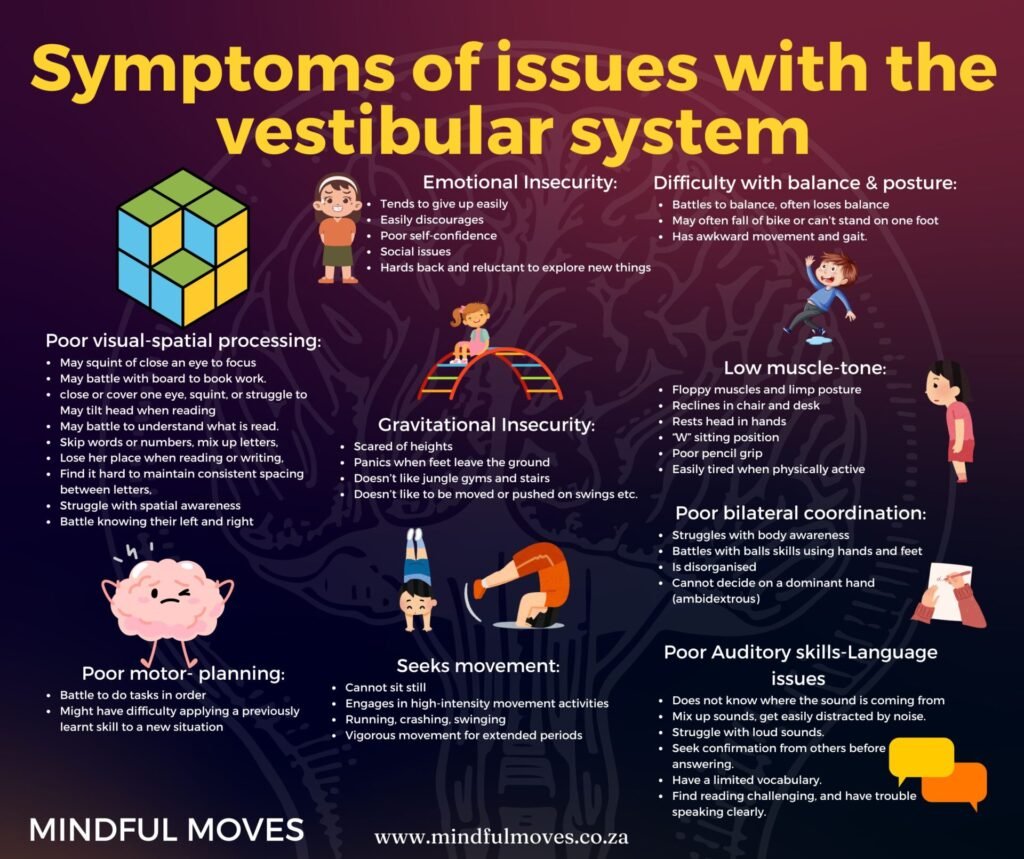
In this article, we delve into the relationship between anxiety and retained primitive reflexes, offering valuable insights. Mindful Moves presents a variety of resources, including courses, neurofeedback, movement programs, and strategies for stress relief. It’s important to note that Mindful Moves does not function as a healthcare provider, and our materials and services are not intended for diagnostic purposes. We aim to support teachers and parents, sharing valuable tools. We also offer Profile Sessions that enhance their understanding of retained primitive reflexes and the associated brain patterns or phenotypes. This article is intended solely for educational purposes. If you’re interested in learning more about our services, feel free to reach out to us directly.
Balance plays a crucial role in helping your child navigate both life and school effectively. The vestibular system is key to a child’s ability to understand their surroundings and maintain an upright posture against gravity. However, many parents and educators may not realize that problems with this system can impact not just balance, but also behavior and emotional development. Therefore, it is essential for adults involved in a child’s life to be aware of vestibular milestones and to monitor any potential issues.
From birth, children start to engage their balance system, which sets the stage for their overall development. As they grow, mastering balance becomes increasingly important. There are two primary types of balance that children need to develop: static balance, which refers to the ability to remain steady while standing or sitting still, and dynamic balance, which involves maintaining stability while in motion. A lack of balance can lead to challenges in the classroom and beyond.
In this article, we will delve into the vestibular system and discuss the implications of a dysfunctional or underdeveloped vestibular system.
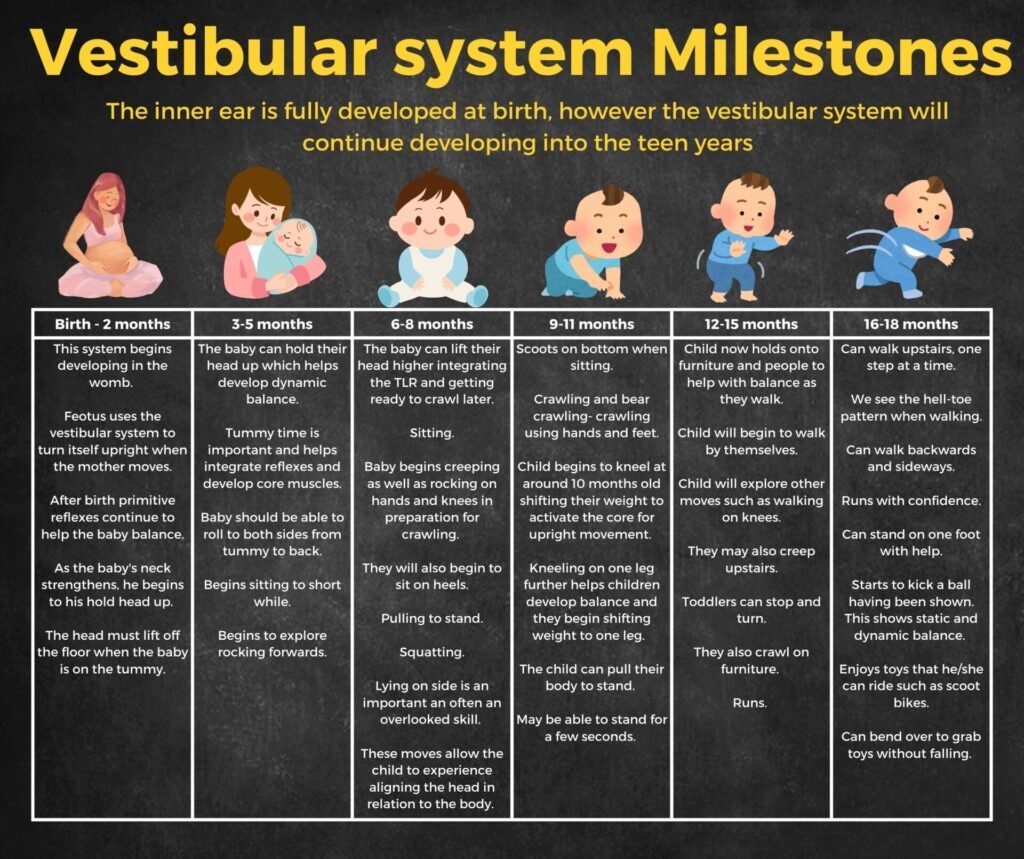
What helps us balance?
The vestibular system plays a crucial role in how we perceive gravity and the orientation of our head. It enables our bodies to maintain balance and stay upright. The vestibular system operates in tandem with the proprioceptive system, providing the brain with critical information. The proprioceptive system relies on receptors in our muscles to relay data about our body’s position and movement, as well as our surroundings through various sensations.
The vestibular system is the earliest sensory system to undergo structural development and start myelination, which occurs around five months post-conception. This intricate system consists of several small organs, with the most sensitive ones located in the mastoid bone and within the inner ear.
Inside our inner ear, there are fluid-filled canals that shift and change direction as we move our heads. This movement is essential for our brain to gauge our position in space. The vestibular system informs the brain whether we are stationary, jumping, or standing, and whether our speed is fast or slow. This information helps us discern if we are moving with or against the force of gravity.
How does balance affect our emotions?
The vestibular system plays a significant role in shaping our learning experiences and emotional responses, primarily due to its connection with the limbic system through the Reticular Activating System (RAS).
When this system is either overly active or not active enough, it can lead to heightened or diminished arousal levels in the limbic system. This part of the brain plays a crucial role in shaping our emotional experiences and perceptions. Depending on its response, the limbic system can trigger either the sympathetic or parasympathetic nervous systems, which may leave us feeling ready to fight, flee, or even freeze in certain situations.
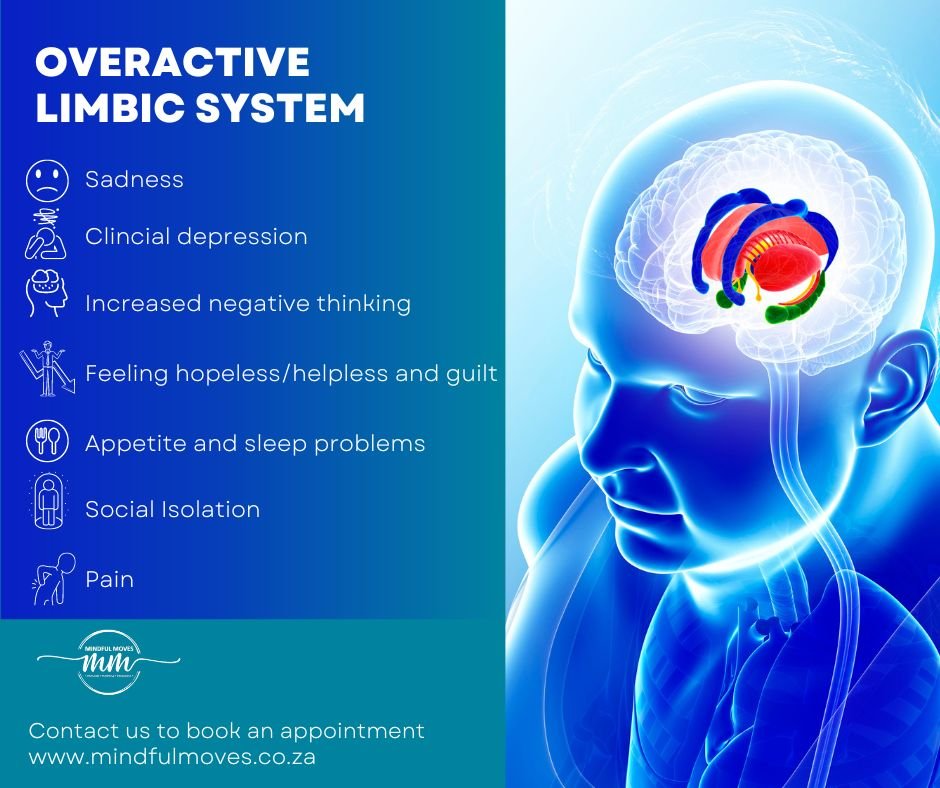
How does the inner ear affect learning?
Dr. Harold N. Levinson, the Director of the Levinson Medical Center for Learning Disabilities, discusses the connection between balance issues and learning difficulties in the foreword of Sally Goddard Blythe’s book, “The Well Balanced Child: Movement and Early Learning.” In his introduction, he praises the book and its aptly chosen title. This insightful read is essential for both educators and parents eager to deepen their understanding of these important topics.
With over thirty years of extensive research into the various symptoms associated with dyslexia and related conditions such as sensory-motor issues, attention deficits, anxiety, and phobias, Dr. Levinson reveals that these challenges stem from a medically identifiable and treatable dysfunction in the inner ear and cerebellum that disrupts signal processing.
Dr. Levinson emphasizes that dyslexia manifests as a complex array of symptoms that can differ significantly in severity. These symptoms impact various higher-order functions, including reading, writing, spelling, mathematics, memory, and speech, among others.
Dr Levinson’s research has shown that therapies targeting the inner ear and cerebellum, along with cognitive enhancement techniques, yielded positive outcomes for individuals exhibiting symptoms of ‘lower-brain origin” such as those associated with dyslexia, learning and memory challenges, attention deficit-hyperactivity disorder (ADHD), dyspraxia, dysphasia, and dysnomia (which involves difficulties in speech and recalling names or tasks). Additionally, these therapies have been beneficial for those with Asperger Syndrome, anxiety disorders, and various mood and self-esteem issues.
Dyslexic Astronauts.
Dr. Levinson explains that excessive spinning and dizziness can provoke dyslexic tendencies, ADHD characteristics, and anxiety in individuals who are otherwise functioning normally. This phenomenon resembles the effects astronauts face in a zero-gravity environment, a condition he describes as ‘space dyslexia.’ Astronauts can reduce this effect by utilizing both medical and non-medical therapies designed to enhance the inner ear and cerebellum before their missions.
Dysfunctions in the vestibular system.
The inner ear and vestibular system play a crucial role in how our brain processes information, particularly when it comes to learning. Any dysfunctions in these areas can significantly disrupt the signals sent to the brain. It’s essential to recognize the connection between the ear and this system. Damage or disturbances that occur during fetal development or shortly after birth can profoundly influence a child’s development and learning capabilities.
Damage to the system may result from the following:
- A stressful pregnancy where reflexes were triggered delaying reflexes that support its development
- A mother who had flu or measles during the second trimester
- Children who were shaken as babies
- Children who had frequent ear infections
- Babies who are bottle fed are at risk of the milk being pushed up into the Eustachian tubes and into the inner ear
- Children who were subjected to secondary smoke
The vestibular and concentration issues.
In her insightful book “Smart Moves,” Dr. Carla Hannaford highlights a significant issue faced by many children diagnosed with ADHD: the impact of stress and deficiencies in the vestibular system. These factors can lead to inconsistent functioning of the Reticular Activating System, which plays a crucial role in maintaining alertness. As a result, these children often experience fluctuations between states of hypo- and hyper-vigilance. It’s important to understand that their struggles with balance are not merely a matter of physical capability. While some may argue that these children can run, it’s essential to recognize that running often resembles a forward fall rather than a demonstration of coordinated movement and balance.
Inadequate vestibular development can lead to children needing to move constantly to stimulate their Reticular Activating System (RAS). These kids often find themselves in challenging situations, resorting to various coping mechanisms to maintain their alertness. For instance, when they are yelled at, they might instinctively try to engage their balance by leaning back on a chair, precariously balancing on its back legs. This behavior often results in further reprimands, with adults insisting they “sit still and pay attention.” This creates a frustrating paradox for these children, as they struggle to activate their RAS in order to pay attention.
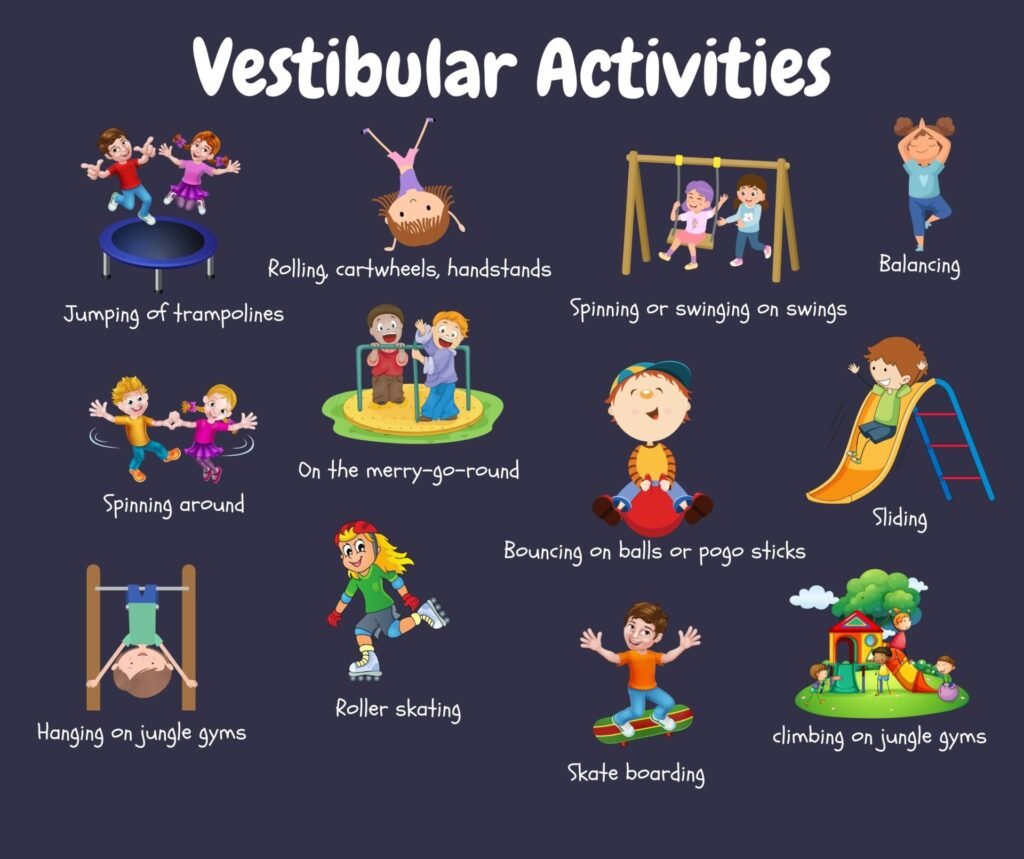
Hearing, language and reading.
Stress during pregnancy can have significant effects on a child’s development, particularly in relation to primitive reflexes. When these reflexes are delayed, it can impact the child’s ability to process language, especially the sounds and patterns they would typically hear from their mother. This early exposure is crucial for later linking sounds to symbols, which is essential for reading. Dr. Carla Hannaford highlights that individuals with dyslexia often have a smaller corpus callosum, the brain structure that connects the two hemispheres, while musicians and singers tend to have a larger one. Additionally, those with dyslexia may show underdevelopment in key areas of the brain, such as the primary sensory and motor cortex, the premotor cortex, and the supplementary motor areas. These brain regions develop through movement, as primitive reflexes evolve into more coordinated and integrated movements, alongside the maturation of the vestibular system.
The vestibular system and the eyes.
An underdeveloped vestibular system can manifest in the muscles responsible for eye movement. This can lead to the eyes either overshooting or undershooting their intended target, which can significantly impact reading ability. When a child expends most of their energy trying to manage eye movements, there is less cognitive capacity available for understanding the text. Some believe that the use of screens exacerbates this problem, as children tend to keep their heads and eyes fixed forward, limiting their chances to develop and strengthen their eye muscles effectively.
To illustrate the connection between the eyes and the vestibular system, you can conduct a simple experiment with your child. Have them spin around until they feel dizzy, then observe how their eyes move rapidly from side to side. Dr. Robert Melillo employs this method to assess the development of the vestibular system through eye movement. In his book “Disconnected Kids,” he explains that ideally, a person’s eyes should stabilize within 12 to 14 seconds after the spinning stops. If the eyes settle in less than 12 seconds, it may indicate an underactive vestibular system, while if they take longer than 14 seconds, it suggests an overactive system.
Denmark Forest Kindergartens.
In countries like Denmark, where children participate in Forest Kindergarten, instances of learning difficulties are uncommon. These young learners engage in activities that stimulate their vestibular system, such as climbing rocks, trees, and hills, as well as rolling and jumping. They spend a minimum of four hours each day immersed in these physical activities, a stark contrast to the mere 30-minute breaks observed in South African Early Childhood Development (ECD) centers that adhere to guidelines set by educational authorities. This disparity highlights a troubling neglect of child development principles and a limited grasp of what truly nurtures young minds.
In these countries, educators quickly engage children in music or choir activities as soon as they identify a child facing learning challenges. They often collaborate with movement therapists to create movement programs tailored to these children. This proactive approach not only aids in developing the vestibular system but also helps alleviate the difficulties the child is experiencing.
How to notice if my child has issues with the vestibular system.
When tackling this question, it’s helpful to start with the most apparent observations. These children are likely to experience challenges with both dynamic and static balance. You might observe the following signs:
- Fear or heights
- Does not like to be pushed on swings
- Clumsy child
- Poor motor planning
- Poor coordination
- Battles with sequencing tasks
- Cannot sit still
- Poor muscle tone
- Battles with to distinguish between left and right
- Battles to establish a dominant hand
- Poor spatial awareness and more
Neurofeedback
When discussing brain activity, it’s crucial to highlight the significance of the sensory motor rhythm (SMR). This rhythm plays a vital role in establishing a connection between the body and the brain. If the brain’s activity in this area is insufficient, individuals may struggle to perceive bodily sensations effectively. The medium brain waves generated by the thalamus facilitate communication between the brain and the external environment. Interestingly, a deficiency in these waves can hinder relaxation, leading to what we observe as ‘hypoactive’ movements in some individuals. Furthermore, those who have experienced trauma often rely more heavily on the brain stem, which can hinder their ability to engage the thalamus and produce these essential medium brain waves. In many cases, children facing attention challenges may exhibit a notable absence of these waves, which are crucial for calming both the body and mind while also filtering sensory input. People with more of the slower brain waves also may appear more anxious and battle with focus.
When it comes to cognitive functions like reading, writing, speaking, and spatial awareness, these activities require a significant amount of energy from the brain. Consequently, we anticipate observing quicker brain wave activity in the areas of the brain associated with these tasks. If the brain isn’t allocating enough energy to these regions or is overexerting itself in other areas, it may indicate that the person is experiencing traits associated with dyslexia, difficulties with numbers, challenges in spatial reasoning, or issues with speech, including both comprehension and pronunciation of words and other learning difficulties.
Excessive energy concentrated in specific areas can lead to various emotional challenges. This imbalance might manifest as outbursts, withdrawal, stubbornness, or defiance. Additionally, it can foster addictive behaviors, emotional detachment, or intense emotional reactions. Individuals may find themselves feeling irritable, restless, or lacking motivation, often grappling with feelings of helplessness or hopelessness, and even experiencing guilt.

So where to start?
We hope this serves as a helpful foundation for you, but we strongly encourage you to connect with us for a deeper understanding of your specific circumstances. This article aims to shed light on how vestibular issues can impact performance, but there may be additional factors at play that are influencing the challenges you’re experiencing.
Mindful Moves employs cutting-edge neurofeedback technology recently brought in from the United States to analyze individual brain patterns, combined with our extensive expertise in retained primitive reflexes. Our approach is holistic, addressing various challenges our clients may face. Additionally, we are pleased to collaborate with educators and schools, having successfully developed strategies and programs that benefit both teachers and parents in supporting their children.
If you’re looking for great reads, I strongly suggest checking out the books I’ve listed above. They are definitely worth your time!
- The Well Balance Child- Movement and Early Learning by Sally Goddard Blythe (ISBN 978 1 903458 63 1)
- Smart Moves- Why Learning Is Not All In Your Head Second Edition by Carla Hannaford, PH.D. (ISBN 978-0-915556-37-3)
- Disconnected Kids by Dr, Robert Melillo (ISBN 078-0-399-17244-1)
- Change Your Brain, Change Your Mind by Dr Daniel Amen (ISBN 978-0-349-41335-8)
